0 导语
随着柔性直流输电技术的发展,直流功率调节将成为电力系统调度过程中一种新的灵活性资源。为充分利用直流调节能力,本文提出了适应数据的交直流混联系统鲁棒机组组合,能够计及电压、无功和损耗,并考虑了可再生能源出力的时空相关性,采用C&CG算法快速求解。
Data-Adaptive Robust Unit Commitment in the Hybrid AC/DC Power System
Bo Zhou, Xiaomeng Ai, Jiakun Fang, Wei Yao, Wenping Zuo, Zhe Chen, Jinyu Wen
期刊:Applied Energy
Abstract/Highlight
This paper proposes the data-adaptive robust optimization for the optimal unit commitment in the hybrid AC/DC power system. With the convexified branch flow model interconnecting the AC and DC power grid, the unit commitment problem in the hybrid AC/DC power system is formulated as a mixed-integer second-order cone programming. Considering the temporal and spatial correlations of multiple wind farms, the data-adaptive uncertainty set and the extreme scenarios are introduced to reformulate the robust optimization. The column-and-constraints generation algorithm is adopted to solve the multi-scenario problem. Case studies in the modified IEEE 14-bus system and the Henan provincial power system demonstrate the applicability of the proposed model. Comparative results with the pure AC power system show the improvement of the flexibility by DC interconnections. Both the operational cost and the times of generator startup/shutdown are reduced. The regulation capability of the DC lines can be fully utilized to cope with the uncertainties introduced by wind power.
1 项目背景
随着柔性直流输电技术的发展和应用,电力系统将由传统的交流系统逐渐演变为交直流混联系统,直流功率调节也将成为电力系统调度过程中一种新的灵活性资源,可增强电力系统的灵活调节能力,进而改善高比例可再生能源接入后的电力系统运行经济性。但是,受潮流模型适用性、随机性建模保守性和混整非线性规划计算方法限制,现有研究尚未在交直流混联系统调度问题中,对直流功率的灵活调节能力进行充分探索和利用。
2 论文所解决的问题及意义
围绕适应数据的交直流混联系统鲁棒机组组合问题,提出了基于混整二阶锥规划的机组组合模型,能够计及电压、无功和损耗,然后考虑可再生能源出力的时空相关性,将模型重构为适应数据的鲁棒优化形式,采用C&CG算法高效求解,可充分利用直流功率灵活调节能力,提高电力系统运行经济性。
3 论文重点内容
1)基于混整二阶锥规划的交直流机组组合模型
该模型电力系统运行成本最小为优化目标,包含煤耗成本和机组启停成本。运行约束由四部分组成,交流电网、直流电网、换流站和发电机组,前三者如图1。发电机组采用传统模型;换流站采用功率模型,并计及换流站损耗;交流电网和直流电网均采用支路潮流模型,可以计及电压无功和损耗。采用凸松弛技术将整体模型进行凸化处理,提高计算效率并保证全局最优。
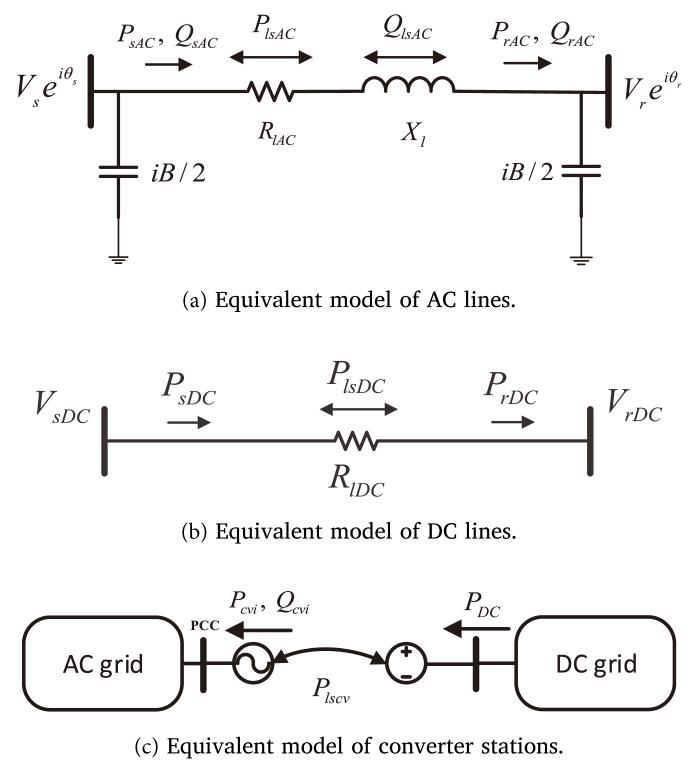
图1 交直流混联电网元件模型
2)适应数据的鲁棒优化重构
基于历史数据,考虑随机性电源出力的时空相关性,提出适应数据的随机性集合,以最小的范围包含所有可能的随机性场景,保证鲁棒性的同时减少保守性,如图2(a)。此外,所提适应数据的随机性集合的极限场景数量与随机量个数为线性关系,如图2(b),可大幅减小计算负担。基于适应数据的随机性集合,将模型重构为两阶段鲁棒优化形式,以最恶劣的随机性场景下运行成本最小为优化目标,并保证所有可能的随机性场景下都能满足运行约束。
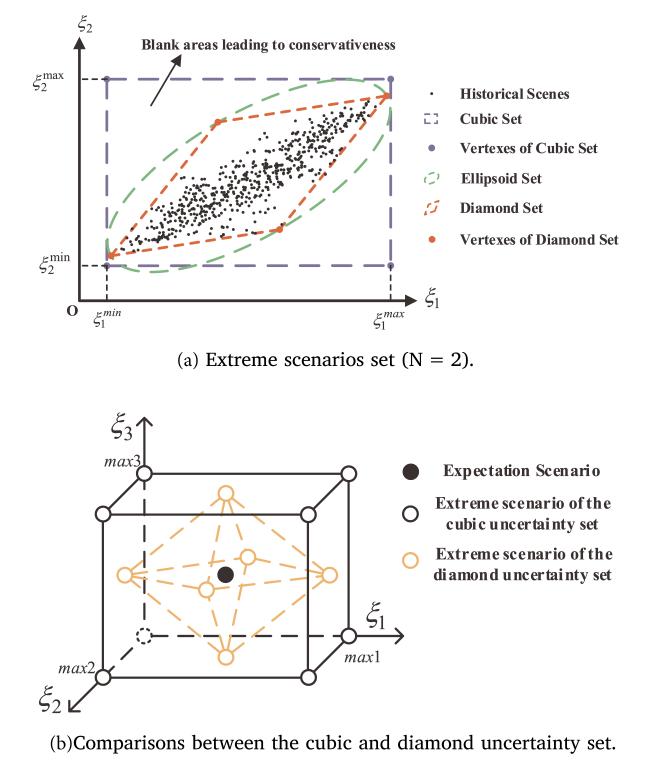
图2 适应数据的随机性集合
3)C&CG算法
采用C&CG算法求解大规模系统多场景混整二阶锥规划问题,如图3。首先将原问题分解为一个主问题(MP)和多个子问题(SP),主问题中仅考虑原问题的少量场景,计算结果为原问题的下界;每个子问题对应原问题的一个场景,且子问题中开机方式固定为主问题计算出的开机方式,所有子问题计算结果的最大值为原问题的上界。每次迭代中,主问题将计算出的开机方式传递到子问题,子问题上界对应的场景添加到下一次迭代的主问题,上下界收敛后得到最优开机方式。
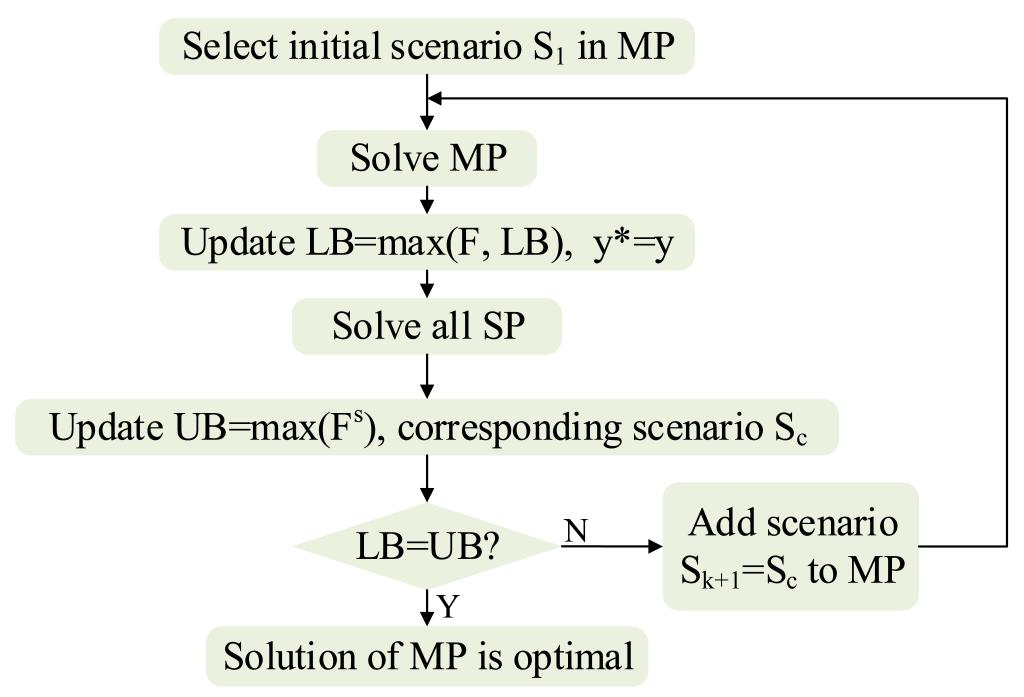
图3 C&CG算法流程
Conclusion
This paper proposes the mathematical formulation and solution algorithm for the data-adaptive robust unit commitment in the hybrid AC/DC power system and analyzes the significant benefits brought by the hybrid AC/DC power grid.
1) The branch flow model-based AC/DC power flow equations are introduced to formulate the unit commitment in the hybrid AC/DC power system as the mixed-integer second-order cone programming. The proposed model can consider the reactive power and power loss, and it is applicable to the hybrid AC/DC power system under uncertainty.
2) The data-adaptive uncertainty set is derived to consider the uncertainty of the wind power generation, and the extreme scenarios are selected to reformulate the data-adaptive robust unit commitment.
3) The column-and-constraint generation algorithm is adopted to solve the mixed-integer second-order cone programming efficiently.
4) Simulation results show that the voltage source converter-based DC line has a wider range of power transmission than traditional AC lines with the same capability, and the hybrid AC/DC power grid is more flexible than the pure AC power grid.
引文信息
Bo Zhou, Xiaomeng Ai, Jiakun Fang, Wei Yao, Wenping Zuo, Zhe Chen, and Jinyu Wen, Data-adaptive robust unit commitment in the hybrid AC/DC power system[J], Applied Energy, vol. 254, 113784, 2019.
https://www.sciencedirect.com/science/article/pii/S0306261919314710
作者简介:
 Bo Zhou received the B.E. degree in electrical engineering from Huazhong University of Science and Technology (HUST), China, in 2017. He is currently pursuing his PhD degree at HUST. His research interests include power system operation under uncertainties and power flow modeling.
Bo Zhou received the B.E. degree in electrical engineering from Huazhong University of Science and Technology (HUST), China, in 2017. He is currently pursuing his PhD degree at HUST. His research interests include power system operation under uncertainties and power flow modeling.
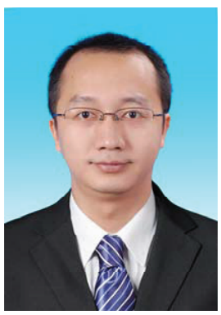
Xiaomeng Ai received the B.Eng degree in mathematics and applied mathematics and Ph.D. in electrical engineering in 2008 and 2014, respectively, both from Huazhong University of Science and Technology (HUST), Wuhan, China. Currently he is a lecturer at HUST. His research interests include robust optimization theory in power system, renewable energy integration, and integrated energy market.
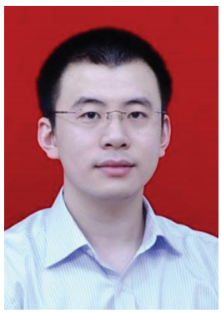
Jiakun Fang received the B.Sc. and Ph.D. degrees from Huazhong University of Science and Technology (HUST), China, in 2007 and 2012, respectively. He was with the Department of Energy Technology, Aalborg University, Aalborg, Denmark from 2012 to 2019. Currently, he is a Professor in Huazhong University of Science and Technology (HUST), Wuhan, China His research interests include power system dynamic stability control, power grid complexity analysis, and integrated energy system.
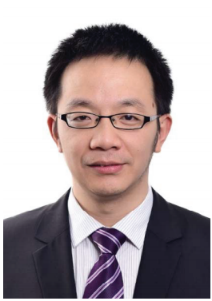 Wei Yao received the B.S. and Ph.D. degrees in electrical engineering from Huazhong University of Science and Technology (HUST), Wuhan, China, in 2004 and 2010, respectively. He was a Post-Doctoral Researcher with the Department of Power Engineering, HUST, from 2010 to 2012 and a Postdoctoral Research Associate with the Department of Electrical Engineering and Electronics, University of Liverpool, Liverpool, U.K., from 2012 to 2014. Currently, he has been an Associate Professor with the School of Electrical and Electronics Engineering, HUST, Wuhan, China. His current research interests include power system stability analysis and control, renewable energy, HVDC and DC Grid, and application of artificial intelligence in Smart Grid.
Wei Yao received the B.S. and Ph.D. degrees in electrical engineering from Huazhong University of Science and Technology (HUST), Wuhan, China, in 2004 and 2010, respectively. He was a Post-Doctoral Researcher with the Department of Power Engineering, HUST, from 2010 to 2012 and a Postdoctoral Research Associate with the Department of Electrical Engineering and Electronics, University of Liverpool, Liverpool, U.K., from 2012 to 2014. Currently, he has been an Associate Professor with the School of Electrical and Electronics Engineering, HUST, Wuhan, China. His current research interests include power system stability analysis and control, renewable energy, HVDC and DC Grid, and application of artificial intelligence in Smart Grid.
 Wenping Zuo received the B.S. degree and Ph.D degree in electrical engineering from Huazhong University of Science and Technology (HUST), Wuhan, China, in 2009 and 2017, respectively. Currently he is a Post-Doctoral Research Fellow with HUST. His research interests include DC grid key equipment, energy storage, and renewable energy integration.
Wenping Zuo received the B.S. degree and Ph.D degree in electrical engineering from Huazhong University of Science and Technology (HUST), Wuhan, China, in 2009 and 2017, respectively. Currently he is a Post-Doctoral Research Fellow with HUST. His research interests include DC grid key equipment, energy storage, and renewable energy integration.
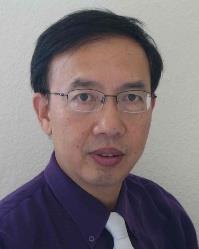
Zhe Chen received the B.Eng. and M.Sc. degrees all in Electrical Engineering from Northeast China Institute of Electric Power Engineering, Jilin City, China, MPhil in Power Electronic, from Staffordshire University, England and the Ph.D. degree in Power and Control, from University of Durham, England. Dr Chen is a full Professor with the Department of Energy Technology, Aalborg University, Denmark. He is the leader of Wind Power System Research program at the Department of Energy Technology, Aalborg University and the Danish Principle Investigator for Wind Energy of Sino-Danish Centre for Education and Research. His research areas are power systems, power electronics and electric machines; and his main current research interests are wind energy and modern power systems.
 Jinyu Wen (M’10) received his B.Eng. and Ph.D. degrees all in electrical engineering from Huazhong University of Science and Technology (HUST), Wuhan, China, in 1992 and 1998, respectively. He was a visiting student from 1996 to 1997 and research fellow from 2002 to 2003 all at the University of Liverpool, UK, and a senior visiting researcher at the University of Texas at Arlington, USA in 2010. From 1998 to 2002 he was a director engineer in XJ Electric Co. Ltd. in China. In 2003 he joined the HUST and now is a Professor at HUST. His current research interests include renewable energy integration, energy storage application, DC grid, and power system operation and control.
Jinyu Wen (M’10) received his B.Eng. and Ph.D. degrees all in electrical engineering from Huazhong University of Science and Technology (HUST), Wuhan, China, in 1992 and 1998, respectively. He was a visiting student from 1996 to 1997 and research fellow from 2002 to 2003 all at the University of Liverpool, UK, and a senior visiting researcher at the University of Texas at Arlington, USA in 2010. From 1998 to 2002 he was a director engineer in XJ Electric Co. Ltd. in China. In 2003 he joined the HUST and now is a Professor at HUST. His current research interests include renewable energy integration, energy storage application, DC grid, and power system operation and control.
期刊简介:Applied Energy,一区SCI,影响因子:8.4。收稿范围包括:化石能源和可再生能源的创新技术和系统,清洁能源的工业利用和家庭使用,同时包括建模和预测,以及能源政策及其对环境、社会和经济的影响。